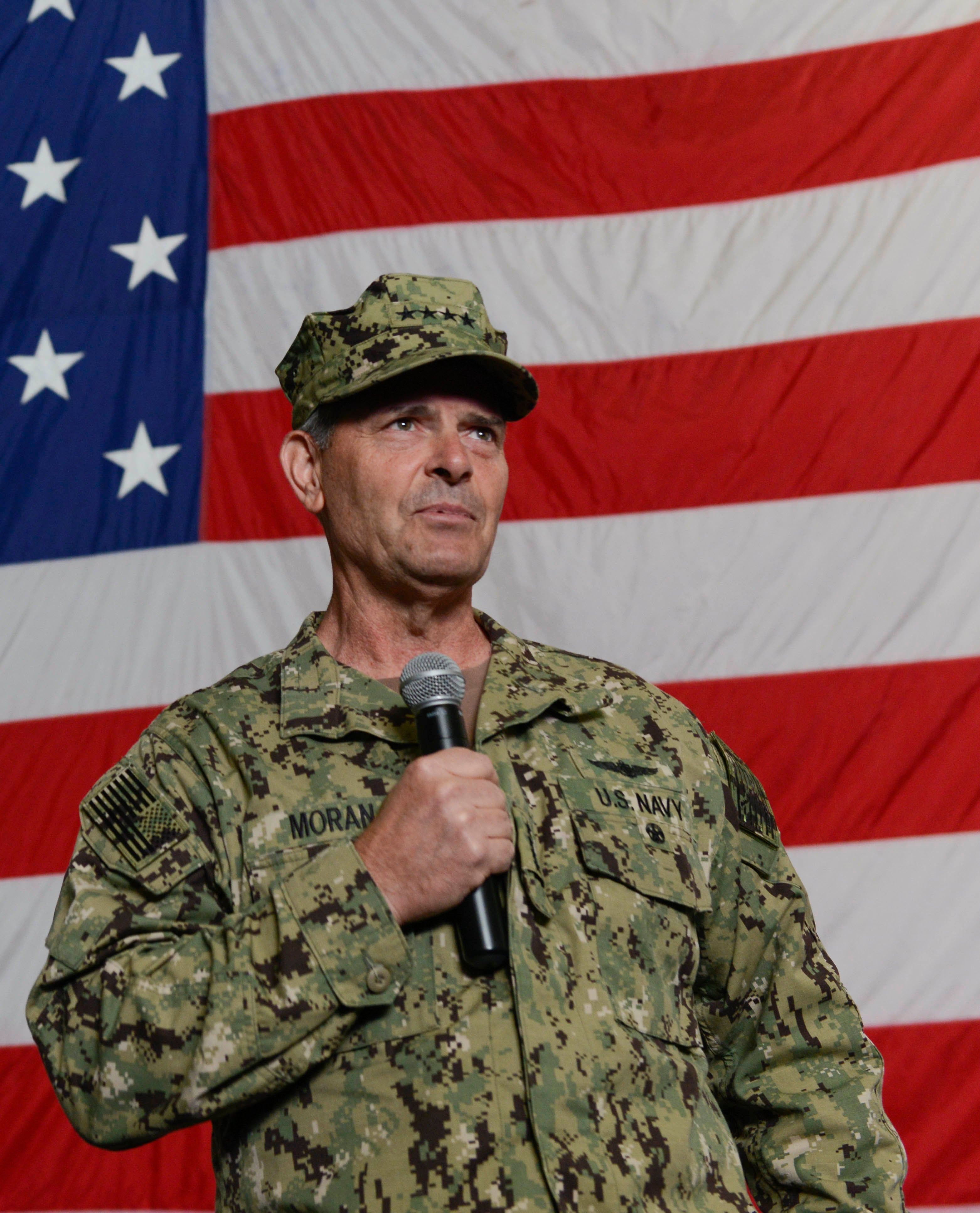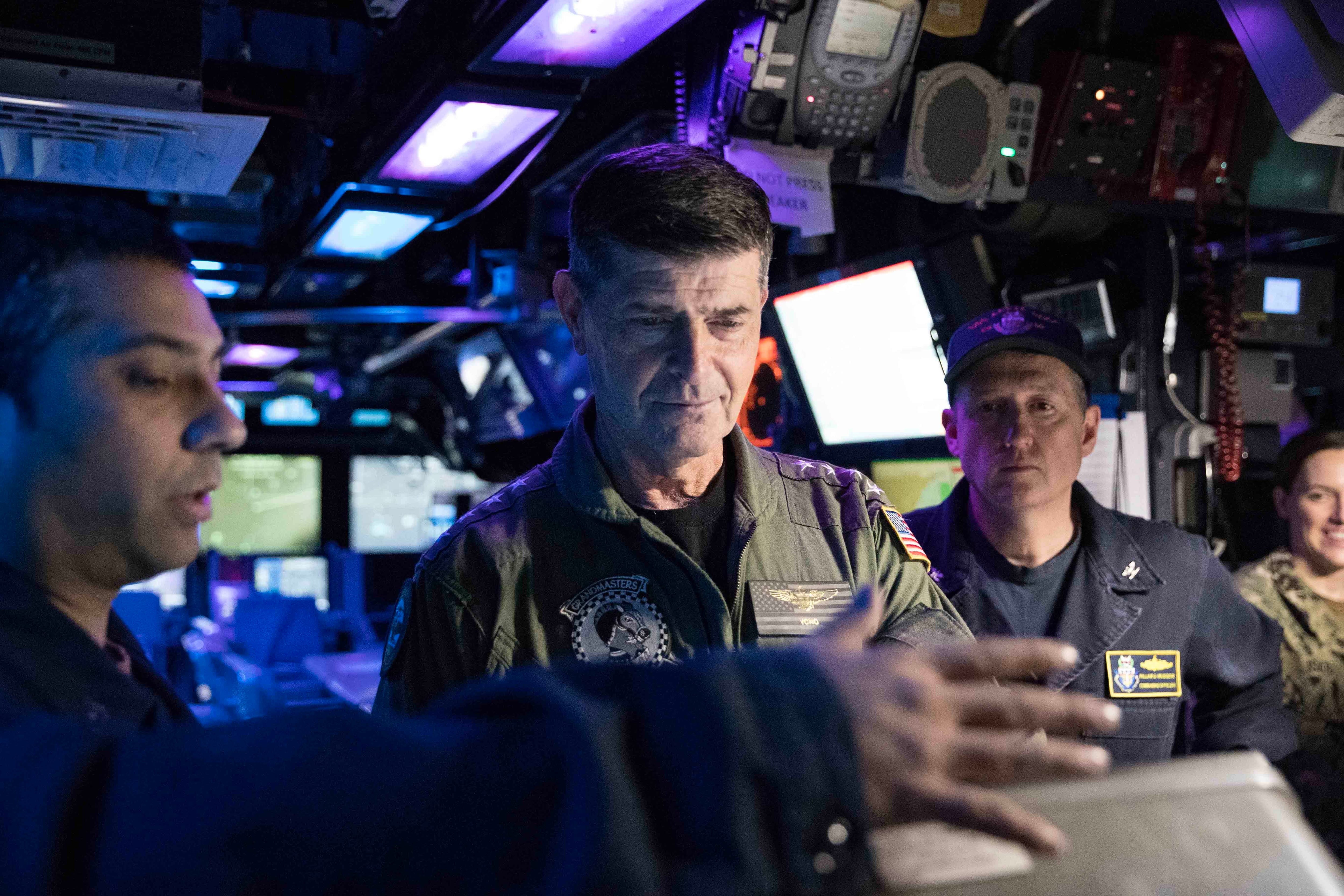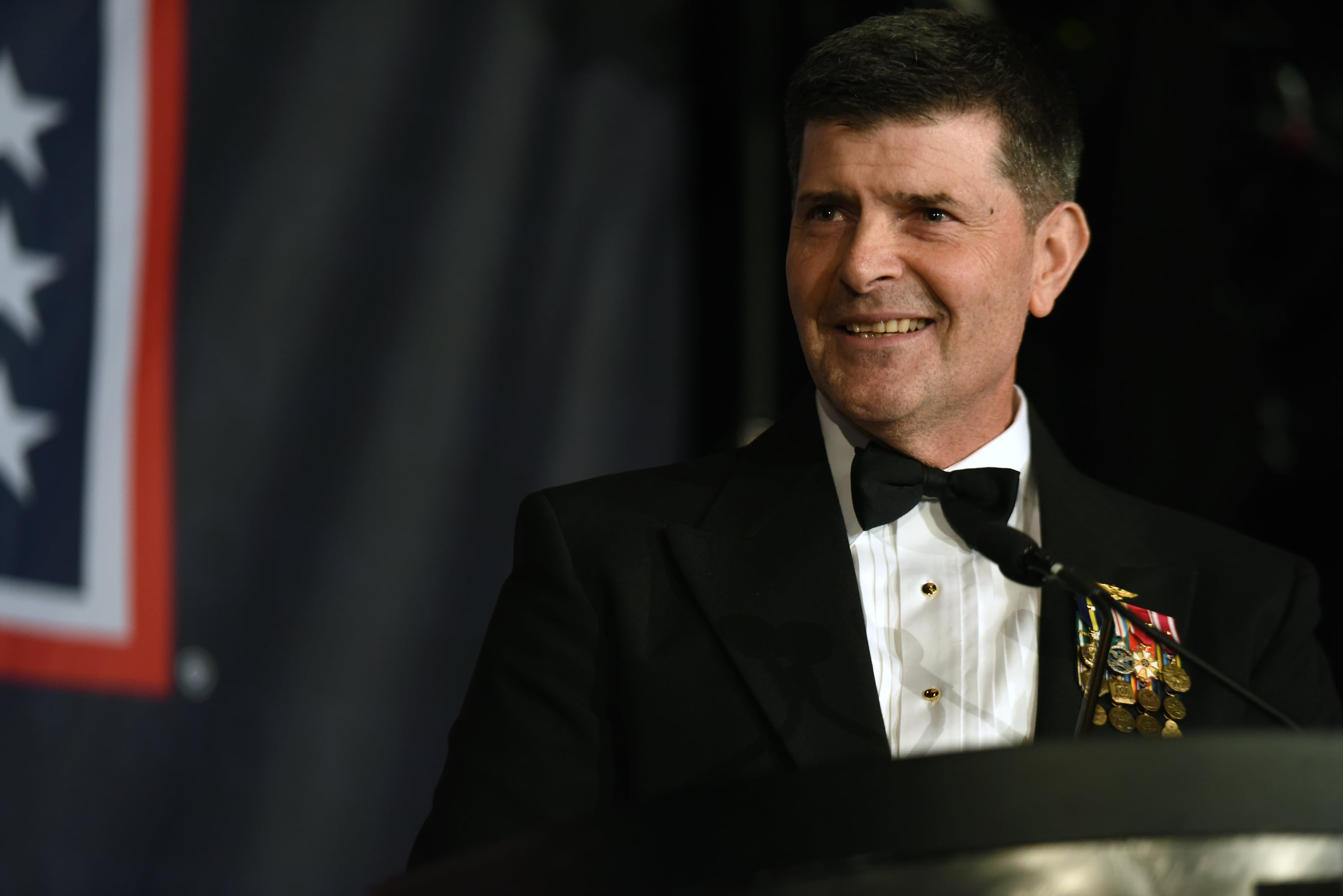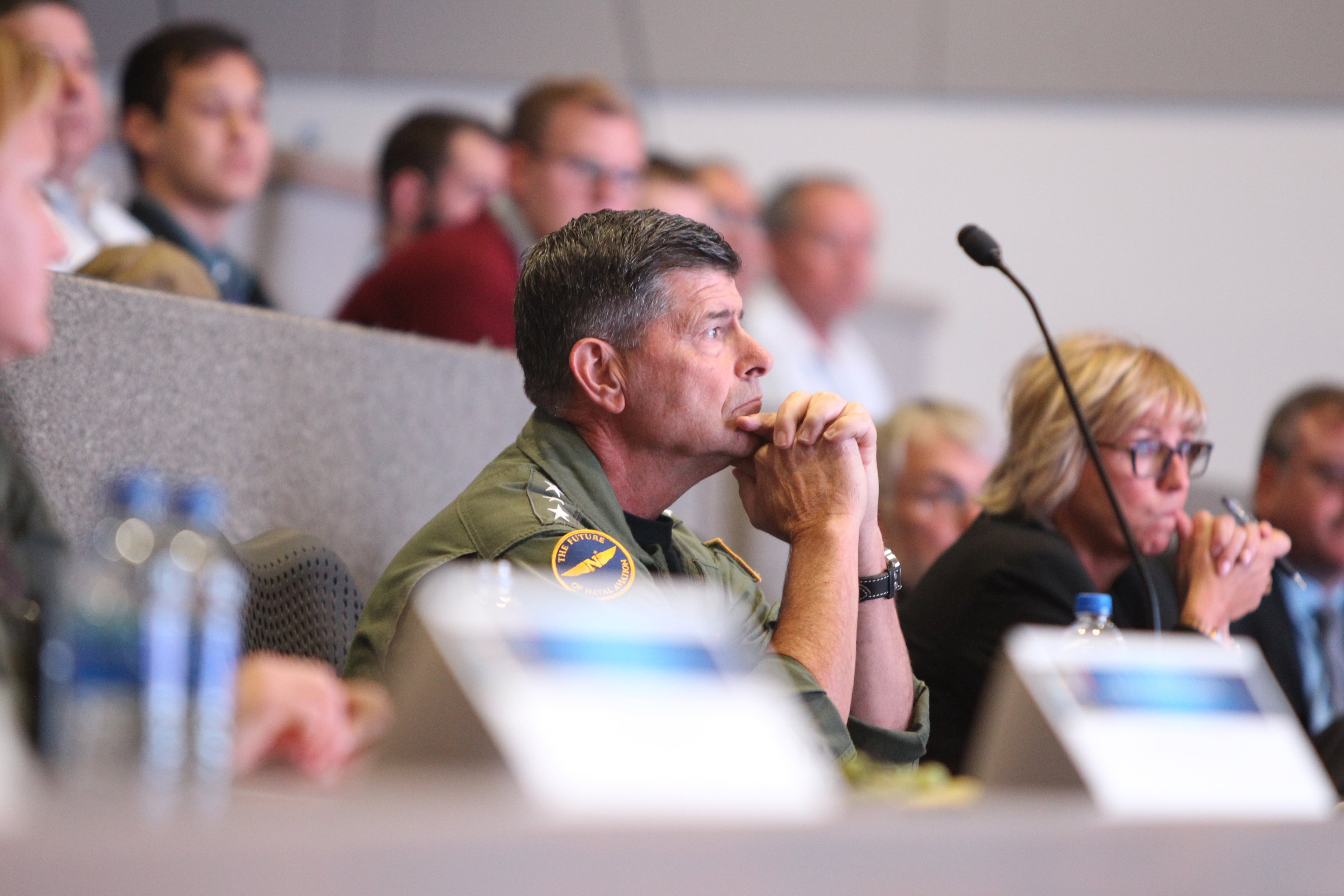The man President Donald J. Trump has nominated to replace Adm. John Richardson as the Navy’s 32nd chief of naval operations is a Cold War aviator who helped reinvent the sea service as its top personnel officer.
If confirmed by the Senate, Adm. William Francis “Bill” Moran will fleet up from his position as the vice chief of naval operations to take the helm of a Navy in flux, pursuing a fleet of 355 warships during an era of increasing competition from Russia, China and other rising powers.
In a prepared statement emailed to Navy Times, Secretary of the Navy Richard Spencer welcomed the White House on the nomination of Moran, calling him “a stalwart partner and adviser."
Richardson told Navy Times he was “thrilled with this announcement” because Moran "is an amazing leader and good friend.”
“He has been central to the Navy adopting a fighting stance in this great power competition,” Richardson said. “As I turn over and go ashore, I will rest easy knowing that, pending confirmation, Adm. Moran has the watch.”
Moran released a terse message, saying only that he was "honored and deeply humbled by the nomination and look forward to working with Congress during the confirmation process.”

Widespread support
Past and present military leaders lauded the president’s decision and urged lawmakers to confirm a four-star they believe is the perfect fit to lead the sea service.
“When he shakes your hand and he says something to you, you look at him and immediately recognize that he’s real and that he cares,” said retired Command Master Chief Aaron Shipley Jr., who served as Moran’s top enlisted adviser after he took command of the Norfolk-based Patrol and Reconnaissance Group in 2008.
Moran is slated to become only the fifth of 39 VCNOs to relieve the CNO as the Navy’s top officer but supporters say he’s uniquely qualified to do the job and they point to his role as chief of naval personnel before taking his current Pentagon post.
As the Navy’s top personnel officer between 2013 and 2016, Moran unleashed a stream of reforms designed to drag the Navy’s human resources system into the 21st century.
Moran’s ambitious “Sailor 2025” program not only has sought to modernize the Navy’s entire personnel system and training process but also change the culture of the sea service to embrace flexibility, reward merit and scrap broad purges of sailors like the despised Enlisted Retention Board.
But it didn’t stop there.
He fought to hike career sea pay and got it.
He wanted to preserve military fitness standards but ditch outdated body composition assessments and won those fights, too.
He tried to muscle the Navy bureaucracy to make it more welcoming to families, including growing the capacity of child development centers, lengthening the hours they’re open, liberalizing paternity and adoption leave and making it easier for military spouses to work in the same community.
As VCNO, Moran also emerged as a candid but insistent voice on Capitol Hill for sustained funding to shore up years of readiness woes.
It was Moran who delivered the stark warning to House Armed Services Committee members in early 2017 that a spending bill was soon to expire and the Navy would almost immediately run out of operations and maintenance funds.
He predicted that without a supplemental infusion of cash the Navy would begin to shutter air wings and defer maintenance for surface ships and submarines.
Lawmakers overwhelmingly passed hefty defense spending hikes, including increased aircraft and shipbuilding procurement and more funding for maintenance.

A man from Walden
A native of the Hudson Valley hamlet of Walden, Moran wasn’t drawn to nearby West Point. Instead, he graduated from the Naval Academy in 1981 and pinned on his golden wings as an aviator in 1982.
A P-3 Orion pilot, his job was to hunt Soviet submarines. That crucial mission took him to Brunswick, Maine and then a long association with Florida — Jacksonville and nearby Naval Station Mayport, home to the famed flattop Forrestal.
From mid-1989 to late 1990, he served on board it as a Carrier Strike Group Six staffer, rising from his role as the admiral’s flag lieutenant to qualify as a Battle Group Tactical Watch Officer.
He got his initial immersion in personnel issues as a detailer at the Bureau of Naval Personnel between 1995 and 1998 but was chosen to command Patrol Squadron 46 and departed for Naval Air Station Whidbey Island.
He went on to command Hawaii-based Patrol Reconnaissance Wing 2 and Patrol and Reconnaissance Group in Virginia before becoming a Beltway fixture in 2010 — first in the office of the Chief of Naval Operations, then as Chief of Naval Personnel and VCNO.
Once confirmed, Moran, 60, will be the first of the nine aviators who became CNO who never rose through the ranks of carrier-based commands.
Retired military leaders who served with Moran over the decades pointed Navy Times to a succession of posts where his competence and commitment telegraphed his ascension to higher rank and greater responsibilities.
They included his stint as a junior captain serving as an executive assistant to Adm. Thomas Fargo at U.S. Pacific Command between 2002-2003 and then a similar task as a senior captain to two chiefs of naval operations nearly a decade later, the position he’s preparing to fill now.
“Shortly after I took over in May of 2002, I had to pick a new executive assistant,” Fargo told Navy Times . “I was so impressed with Bill that I moved him up into that slot.”
To Fargo, it was an unusual move. Typically, those slots are reserved for senior captains soon to pin on their first stars. Rarely do the go to “fresh-caught” captains who had yet to hold a major command, he said.
“He was so impressive in terms of his ability to work with the senior officers on the staff as well as the action officers, folks external to the command, that I just made the decision to bring him into that job at an early point in his career," Fargo said.
Selected for flag rank a dozen years before he retired, Fargo recalled a number of good executive assistants but said the most junior of them, Moran, “was at the very top.”
That assessment was shared by retired Adm. William "Shortney” Gortney, who helmed both U.S. Fleet Forces Command and North American Aerospace Defense Command, U.S. Northern Command.
A career aviator with 1,265 carrier-arrested landings, mostly in the A-7E Corsair II and the FA-18 Hornet attack jets, Gortney said he likes to chide Moran on his P-3 lineage, but he’ll never disparage Moran’s proven ability to tirelessly conquer any task.
Gortney marked Moran as a rising star while watching him serve as the executive assistant to CNOs Mike Mullen and Gary Roughead.
“We all saw his innate skills,” Gortney said. “He has the ability to pick things up — fast — to listen and understand quicker than almost anyone and that’s why he can be given any task and he’ll proceed to knock it out of the park.”
Fargo and Gortney said it was that drive and intelligence that made him a two-star and sent him to become the Director of Air Warfare on the CNO’s staff. By their reckoning, he was one of the best to ever hold the post.
“I believe he was the first and only P-3 guy to be given that job, and again, he was given that job at a more junior level than that job has normally seen in the past,” Fargo said. “But he has such a command of not only the aviation community, but the Navy at large that he was more than up to the task and, in fact, excelled in the job.”
His secret, they said, was Moran’s ability to study and solve problems, coupled with communication and listening skills that connect him up and down a chain of command, quickly developing strong ties, and trust.
“I think that’s one of the reasons, because he engages and listens really well,” Fargo said.
“He goes out and figures things out first-hand. His willingness to go forward and spend time with the operators and work to understand their problems is how he’s done business his whole career.”

Ambassador to the Goat Locker
Those bonds weren’t merely forged with senior officers but also enlisted sailors.
Retired Command Master Chief Shipley told Navy Times that Moran has a deep understanding of the role of the chiefs mess. As a commissioned leader, Moran would tap into the authority of the Goat Locker in a self-effacing and genuine way, the same way he interacts with everyone, Shipley remembered.
“The first opportunity we had to really talk, once he took command I took him over to the chief’s mess for lunch,” Shipley said. “We talked about everything, but at one point, he came out and told me that ‘I’m going to need your help to learn how to be a flag officer.’”
Shipley didn’t think that Moran really needed his help to become a flag but he understood the sort of counsel he was seeking. To the command master chief, it was “my first of many aha moments with him,” episodes when he saw Moran’s sincerely “humble and modest kind of leadership style.”
On all hands calls across the globe, Shipley watched Moran “listen more than he talked.” When a sailor asked a question Moran couldn’t immediately answer, he’d promise to find out “and would always follow through, even if it took weeks.”
He often made the phone call or wrote the email himself instead of delegating the duty, Shipley remembered.
“That builds trust,” he said.
Shipley recalled Moran donning a flight suit and visiting squadrons at odd hours, simply to talk to sailors to canvass their views. That irked a few commanding officers, Shipley said, until they began to see Moran’s true motives.
“They learned that he wasn’t coming to inspect them,” Shipley said, only to hear their unvarnished thoughts.
Moran also watched his senior enlisted adviser and noticed he was always hanging out at smoke pits.
“Moran knew I wasn’t a smoker, asked me why I was always out there,” Shipley recalled. “I told him it’s because you get a new crowd every 10 minutes.”
Like Moran, Shipley wanted to hear raw opinions and complaints. So Moran started accompanying him to the pits or making solo trips.
Over time, Moran’s respect for the chiefs mess became mutual. While serving with him, Shipley decided to make a pitch to then-Master Chief Petty Officer of the Navy Rick West to anoint his boss as an honorary master chief.
But before he went to MCPON, he took a poll of the Group’s subordinate command master chiefs and they voted unanimously to honor Moran.
What was true for that Group was true for the Navy’s collective chiefs mess, according to retired Fleet Master Chief April Beldo.
She served as Moran’s top enlisted adviser during his 13-month tour as the chief of naval personnel.
“What you see is what you get with Adm. Moran,” Beldo said, a quality he also expects from his staffers.
She said that he respects “you for what you’ve accomplished” but at the same time he expects his officers and sailors to live up to them and if they didn’t, “we were going to have a conversation about that.”
To Beldo, Moran commanded excellence from his subordinates because “no one wants to let him down.”

Right man, right time
All of the retired flags and senior enlisted contacted by Navy Times said Moran was the best choice to lead the sea service.
“You can always come up with reasons why someone shouldn’t be picked for the job and I’m sure that will happen,” Gortney said. “But if you look at what he’s done and what he’s accomplished everywhere he’s been, there’s no reason to believe he won’t do a phenomenal job as CNO, too.”
Beldo and Shipley said they weren’t surprised when they heard Moran got the nod for CNO.
Beldo chalked his rise up to being a “totally fair and honest leader who leads by his own example and brings the same out of others.”
Shipley suspects it’s because Moran is the real deal and everyone in the Navy knows it.
"Sailors can smell a fake from miles away," Shipley said. "Likewise, they know from the instant they either meet him or hear him speak that he's about as real and genuine as they come."
He realizes it could sound like a cliché, but Fargo believes Moran is “the right leader at the right time” and comes armed with the “policy people and budget experience to lead the Navy very effectively.”
To Fargo, the best thing about Moran is that he “is absolutely forthright and transparent with truth" and his inherent credibility resonates down the ranks.
As an aviator, Gortney says he’s happy to see another flyer in the Navy’s top spot but insists Moran is really just the best candidate for the gig.
“I don’t want to spoil it, but I will predict he will be one of the great CNOs as well," Gortney said.
Mark D. Faram is a former reporter for Navy Times. He was a senior writer covering personnel, cultural and historical issues. A nine-year active duty Navy veteran, Faram served from 1978 to 1987 as a Navy Diver and photographer.





